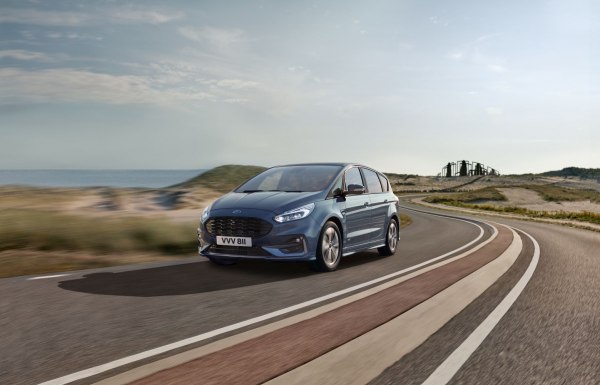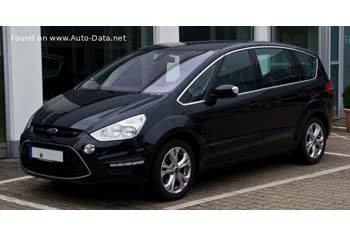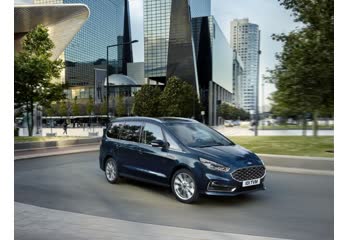Everything you need to know about specifications and performance - Ford S-MAX 2021 - 2.5 (190 Hp) Hybrid CVT 7 Seat

Overview:
What is the engine capacity of a Ford S-MAX 2021?
The engine capacity of the Ford S-MAX 2021 is 2488 cm.
Ford S-MAX 2021 How many horsepower?
The engine power of the Ford S-MAX 2021 is 150 Hp.
What is the Ford S-MAX 2021 engine?
Ford S-MAX 2021 engine is BGCA. (Click to see other cars using the same engine)
How powerful is the electrical system in the Ford S-MAX 2021?
The power of the electrical system in the Ford S-MAX 2021 is 190 Hp @ 5500 rpm. hp.
How much gasoline does a Ford S-MAX 2021 consume?
The Ford S-MAX 2021 consumes 5.6 liters of gasoline per 100 km
General:
Brand: Ford
Model: S-MAX
Generation: S-MAX II (facelift 2019)
Modification (Engine): 2.5 (190 Hp) Hybrid CVT 7 Seat
Start of production: February, 2021
End of production: April, 2023
Powertrain Architecture: FHEV (Full Hybrid Electric Vehicle)
Body type:Multi Purpose Vehicle (MPV)
Seats: 7
Doors: 5
Engine:
Engine systems: Start & Stop System
Power: 150 hp
Power per litre: 60.3 hp/l
Torque: 200 nm
Engine Model/Code:BGCA
Engine displacement: 2488 cm
Number of cylinders: 4
Engine configuration: Inline
Number of valves per cylinder: 4
Fuel injection system: Multi-port manifold injection
Engine aspiration: Naturally aspirated Engine
Valvetrain: DOHC, VCT
Engine oil capacity: 5.4 l
Engine layout: Front, Transverse
Cylinder Bore: 89 mm
Piston Stroke: 100 mm
Compression ratio: 13
Performance:
Fuel Type: Petrol (Gasoline)
Fuel consumption (economy) - urban: 6.3 l/100 km
Fuel consumption (economy) - extra urban: 5.2 l/100 km
Combined fuel consumption (WLTP): 6.4 l/100 km
Fuel consumption (economy) - combined (NEDC): 5.6 l/100 km
Fuel consumption (economy) - urban (NEDC): 6.3 l/100 km
Fuel consumption (economy) - extra urban (NEDC): 5.2 l/100 km
Fuel consumption (economy) - combined: 5.6 l/100 km
Emission standard: Euro 6d-ISC-Fcm
Acceleration 0 - 100 km/h: 9.8 sec
Acceleration 0 - 62 mph: 9.8 sec
Maximum speed: 185 km/h
Weight-to-power ratio: 9.9 kg/Hp, 101.5 Hp/tonne
Weight-to-torque ratio: 9.4 kg/Nm, 106.8 Nm/tonne
Acceleration 0 - 60 mph: 9.3 sec
Electric system:
Gross battery capacity: 1.1 kWh
Battery technology: Lithium-ion (Li-Ion)
Battery location: Below the floor
System power: 190 hp @ 5500 rpm.
System torque: 200 nm
Electric motor power: 133 hp
Electric motor type: Synchronous
Space:
Kerb Weight: 1872 kg
Max. weight: 2545 kg
Max. roof load: 75 kg
Max load: 673 kg
Trunk (boot) space - maximum: 2020 l
Trunk (boot) space - minimum: 185 l
Permitted trailer load with brakes (12%): 1560 kg
Fuel tank capacity: 65 l
Permitted trailer load without brakes: 750 kg
dimensions:
Length: 4804 mm
Width: 1916 mm
Height: 1684-1710 mm
wheelbase: 2850 mm
Width with mirrors folded: 1953 mm
Width including mirrors: 2137 mm
Front track: 1606 mm
Rear (Back) track: 1606 mm
Ride height (ground clearance): 140 mm
Minimum turning circle (turning diameter): 11.95 m
Powertrain, Suspension and Brakes:
Drivetrain Architecture: The Internal combustion Engine (ICE) and electric motor drive the front wheels of the car with the ability to work in full electric or mixed mode.
Drive wheel: Front wheel drive
Number of gears and type of gearbox: automatic transmission CVT
Front brakes: Ventilated discs, 316x28 mm
Rear brakes: Disc, 316x11 mm
Assisting systems: ABS (Anti-lock braking system)
Steering type: Steering rack and pinion
Power steering: Electric Steering
Tires size: 235/55 R17; 235/50 R18; 245/45 R19
Wheel rims size: 7.5J x 17; 7.5J x 18; 8J x 19
Front suspension: Independent, type McPherson with coil Spring and anti-roll bar
Rear suspension: Independent multi-link Spring suspension with stabilizer
See also

Other generation.
Its production began in 2010 until 2014

Same engine. (BGCA).
Its production began in 2021 until 2023
Write a comment